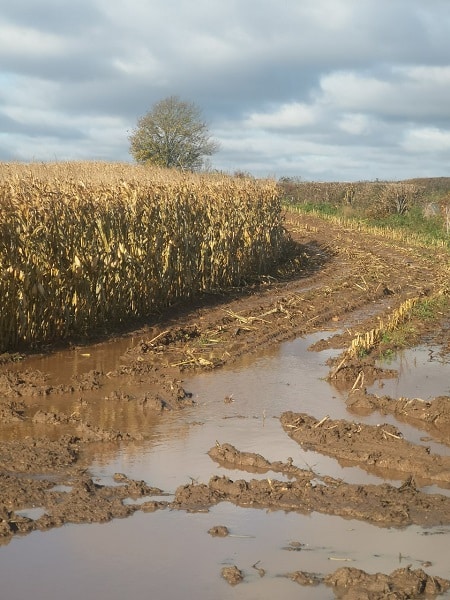After the success of their Anaerobic Digestion Workshop, Carbogenics are thrilled to announce they are…
MEMBER PRESS RELEASE: Flooded maize could be salvaged as grain for AD feedstock
Flooding across north, east and central England has brought the last of the maize harvest to a halt, and reports suggest thousands of acres destined for anaerobic digestion remain in the ground. While taking the crop as silage becomes increasingly unlikely, feedstock and forage preservation specialists, Kelvin Cave Ltd, say there may still be options which will salvage maximum value from the crop in its current condition.
“Most of the UK’s maize for anaerobic digestion is harvested as wholecrop silage, but much of the crop remaining in the ground has severely decreased in digestibility and biogas potential,” says the company’s northern area manager, Michael Carpenter.
Michael is speaking at the ADBA Learning & Development event, “Feedstock, Sampling and Digester Health” on 26th November in Crewe. Click here to see the full agenda and register your place.
“While it’s generally now impossible to harvest as silage in the current wet conditions, it will still be possible to call in a contractor or get the combine out of the shed to harvest only the cob,” he says. “This leaves the stover in the field and provides a bed of stalks and leaves on which to drive, which makes a massive difference to the cleanliness of the harvest, reducing the removal of soil from the field and cutting soil compaction.”
However, the biggest bonus to be gained from the process is by taking the grain, which generally remains in good condition and can be preserved by crimping at moisture contents of between 25 and 35 per cent.
“There’s a widespread misunderstanding that maize is difficult to harvest for grain in the UK and is likely to require drying,” he says. “But by using a crimping preservative instead, it can simply be rolled and treated on the day of harvest and compacted and covered in a clamp.
“The resulting high energy fermented, concentrate feedstock is of a high value for anaerobic digestion, giving excellent biogas yields.
“Although we are not advocating waiting longer than necessary, there is also a far larger window of opportunity for a grain harvest,” he adds. “The cob is generally better protected from disease and the elements, and we know of growers who have successfully harvested and crimped grain maize beyond the New Year!”
Independent silage consultant, Dr Dave Davies from Silage Solutions reinforces the challenges of preserving maize silage as the crop matures beyond its optimum 32-35 per cent dry matter.
“As wholecrop maize matures, so its dry matter increases while its digestibility, energy content and total harvestable yield go into decline,” he says. “The plant as it dies also becomes more prone to fungal infection in the field, greatly increasing the challenge of aerobic spoilage of the silage when the clamp is opened for feed-out.
“The highest harvestable yield for maize silage occurs at around 33 per cent dry matter,” he continues. “But as dry matter increases, harvestable yield rapidly declines, by 10 and 15 per cent at 45 and 50 per cent dry matter respectively.”
Charlie Bowyer who offers independent nutrition advice for AD plants through Biologic Biogas Solutions Ltd, knows growers who are now considering switching from forage to crimped grain maize in view of conditions.
He says: “With this year’s abysmal maize harvest, we are seeing over-mature maize crops with high dry matter, highly lignified stover. Very high DM wholecrop maize silage can create some serious headaches in the clamp with poor compaction leading to poor aerobic stability, losses of biogas yield and potentially problems in the AD tank, such as crusting and depressed performance.
“The high dry matter, poorly digestible stover can increase the potential for floating layers and will progressively lengthen the retention time requirement of the silage as the maize matures beyond the normal wholecrop harvest point.
“If silage quality in-clamp really starts to suffer, there is also the potential for volatile fatty acids in the silage to upset the VFA profile, particularly if the biological system is short of trace elements,” he says.
“Crimping means you can negate some of these issues by leaving the stover in the field and get a real bang-for-your-buck by producing feedstock which would be ideal for many biogas plants, particularly those with a short retention time and no maceration.
“Crimped maize grain is a highly digestible feedstock for AD with the potential to yield over 500m3 of biogas per fresh tonne, depending on dry matter and quality,” he says.
In order to preserve maize in optimum condition, Kelvin Cave recommend treating it with Crimpsafe 300, a product containing preservation ingredients which are licensed for use with human food.
“This preservative works by controlling the fermentation of crimped grain, thereby retaining its feedstock value and biogas potential, cutting the losses which would occur in a poorly controlled fermentation,” says Mr Carpenter. “The formulation is designed to give maximum protection against spoilage organisms which could cause deterioration of the feedstock once the clamp is opened.
“Independent farm-scale trials have shown that Crimpsafe 300 will keep crimped grain fresh and stable for up to 300 hours after exposure to air, as reflected in its name,” he says.

A contractor’s view
Tim Russon runs an agricultural contracting service across Lincs, Notts and Yorks and says most of the maize in his area has long past the foraging stage, leaving very few alternative options.
“One of these is to harvest and crimp the grain which will salvage the best of the crop, which I am doing for both anaerobic digestion and livestock feed,” he says.
“We have around 1,200 acres of maize left to harvest and a number of our customers have agreed that combining the grain is the best way forward.
“We would ideally do this at the earliest opportunity but the ground is still too wet. But by taking this option, with weather and ground conditions permitting, we can salvage it right through till March.”
What is crimping
Crimping involves the rolling of cereals or maize grain through a crimping machine to expose the carbohydrate and protein, and the application of a preservative. This ensures maximum nutrient retention once stored in an airtight clamp (or plastic tube). A range of modern preservatives allows maize to be crimped at moisture contents of 25-40%.
Why crimp grain maize
Provides high value feedstock for anaerobic digestion
Typical maize grain yield at 30% moisture is 4-5t/acre (10-12t/ha)
No drying or specialist storage is required
A wet maize grain harvest causes less soil movement, contamination and damage than maize silage
Can yield about 500m3 of biogas per fresh tonne depending on DM and quality
Backed by over 40 years successful use in Finland and northern Europe
For more information about the crimping process, please contact Kelvin Cave Ltd on 01458 252281, Michael Carpenter on 07817 977701 or Charlie Bowyer from Biologic Biological Solutions Ltd on 07875 103430.
NOTES FOR EDITORS
Photos of water-logged maize fields now destined for grain harvest are attached.
Kelvin Cave Limited provides products and technical support to farmers and contractors producing home-grown animal feeds. The company specialises in crimped and moist grain preservatives, grain-processing machinery, silage preservatives and additives and clamp protection systems.
For further information please contact the Kelvin Cave Ltd head office on 01458 252281.




